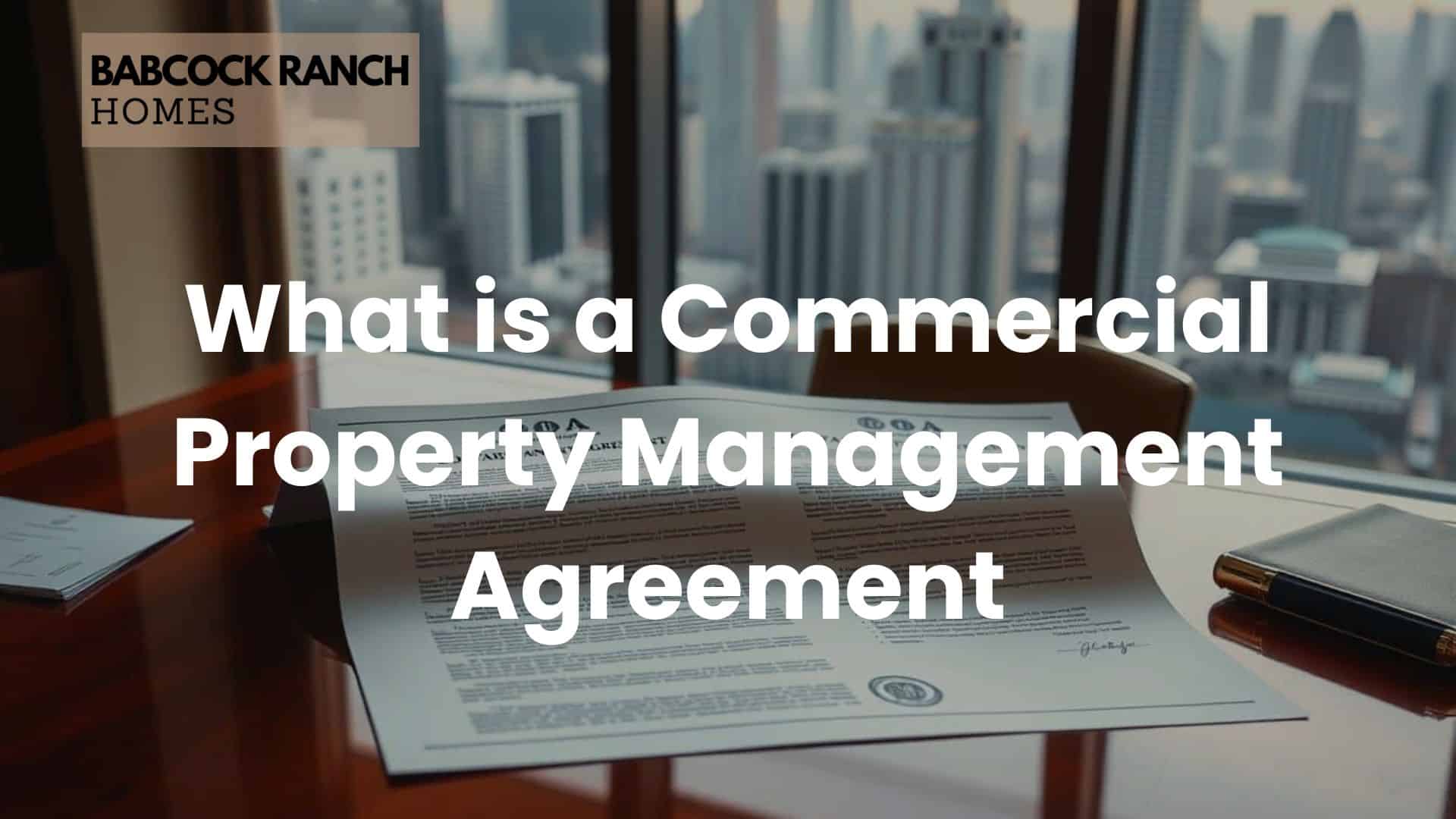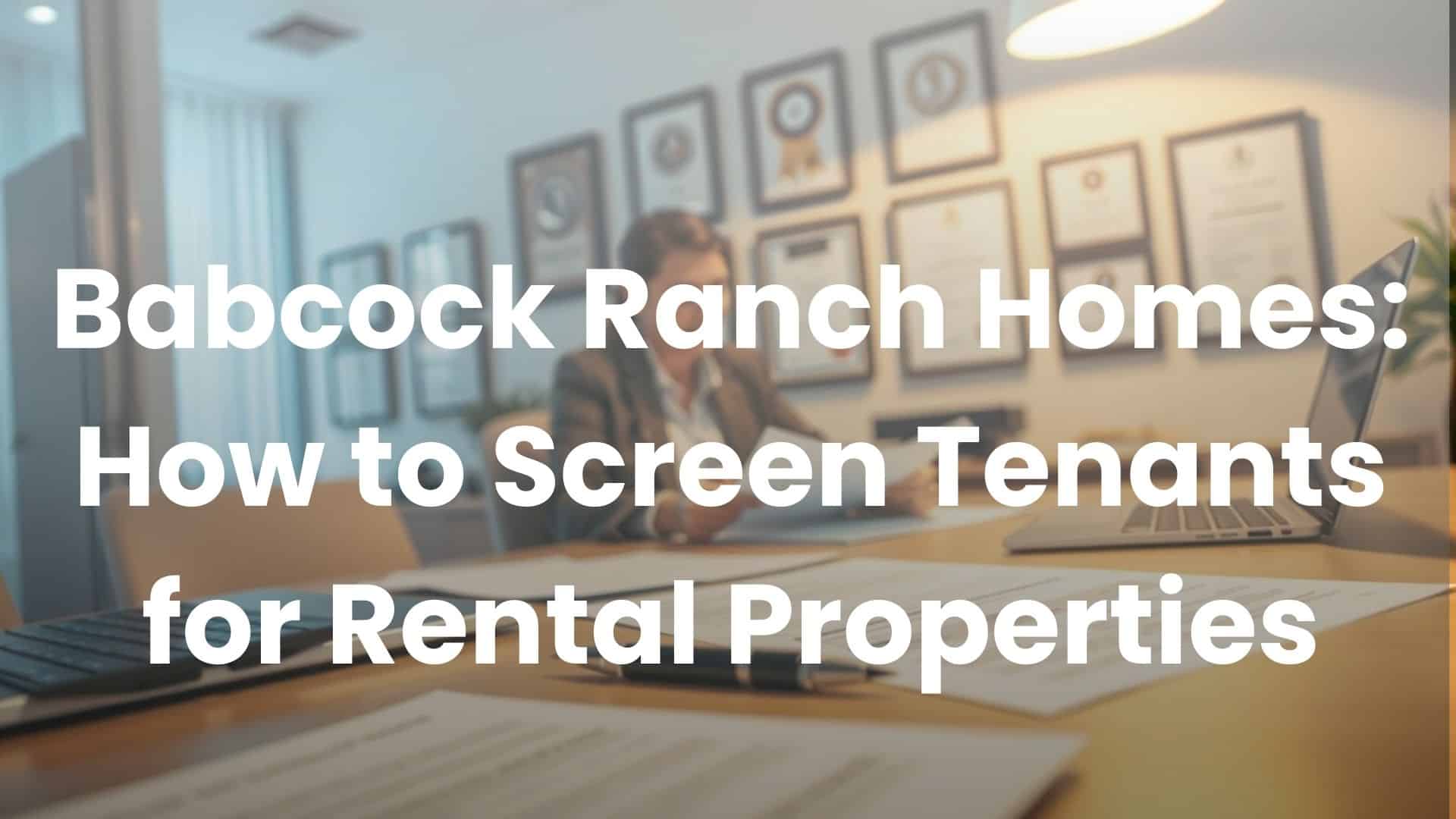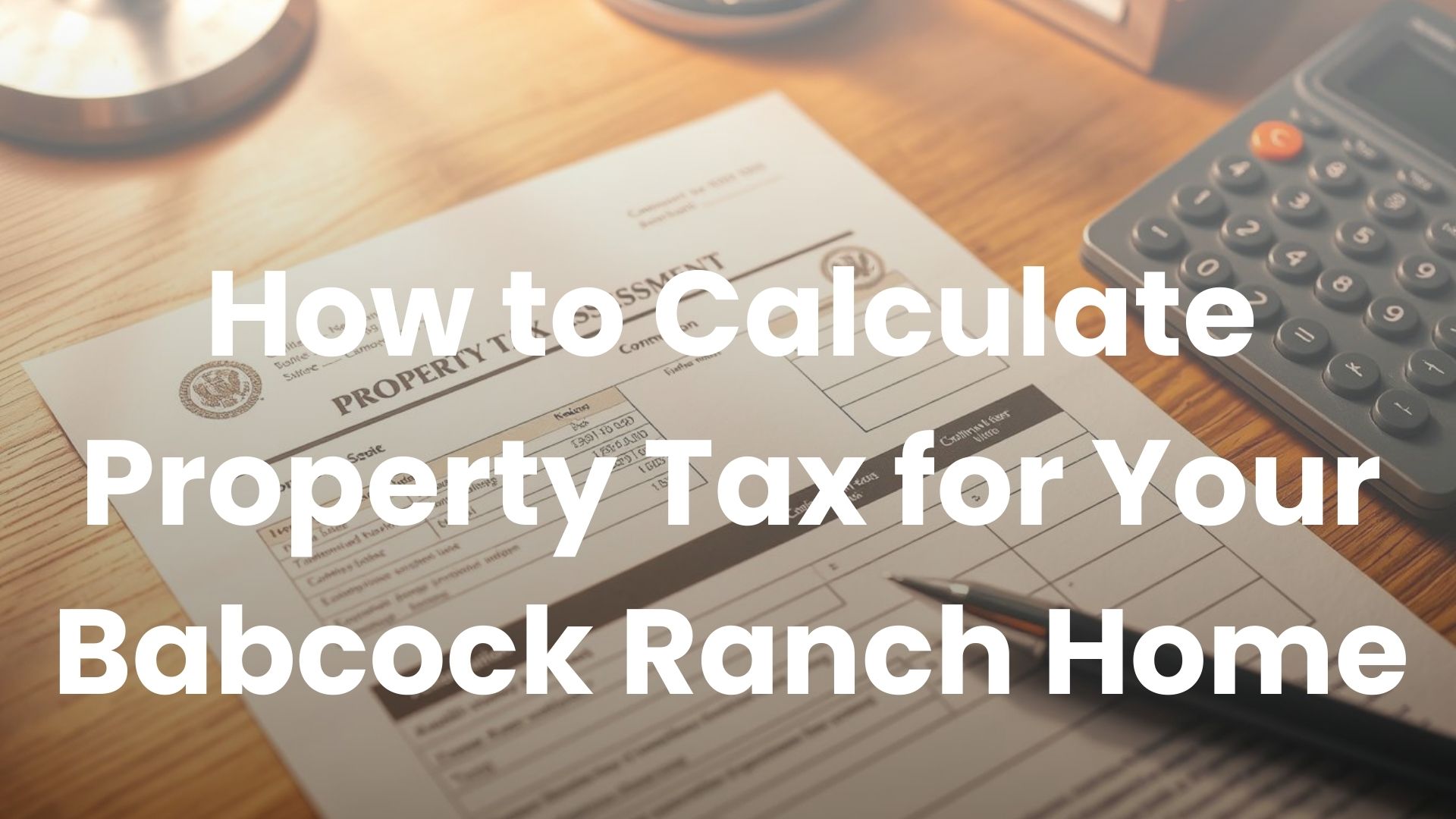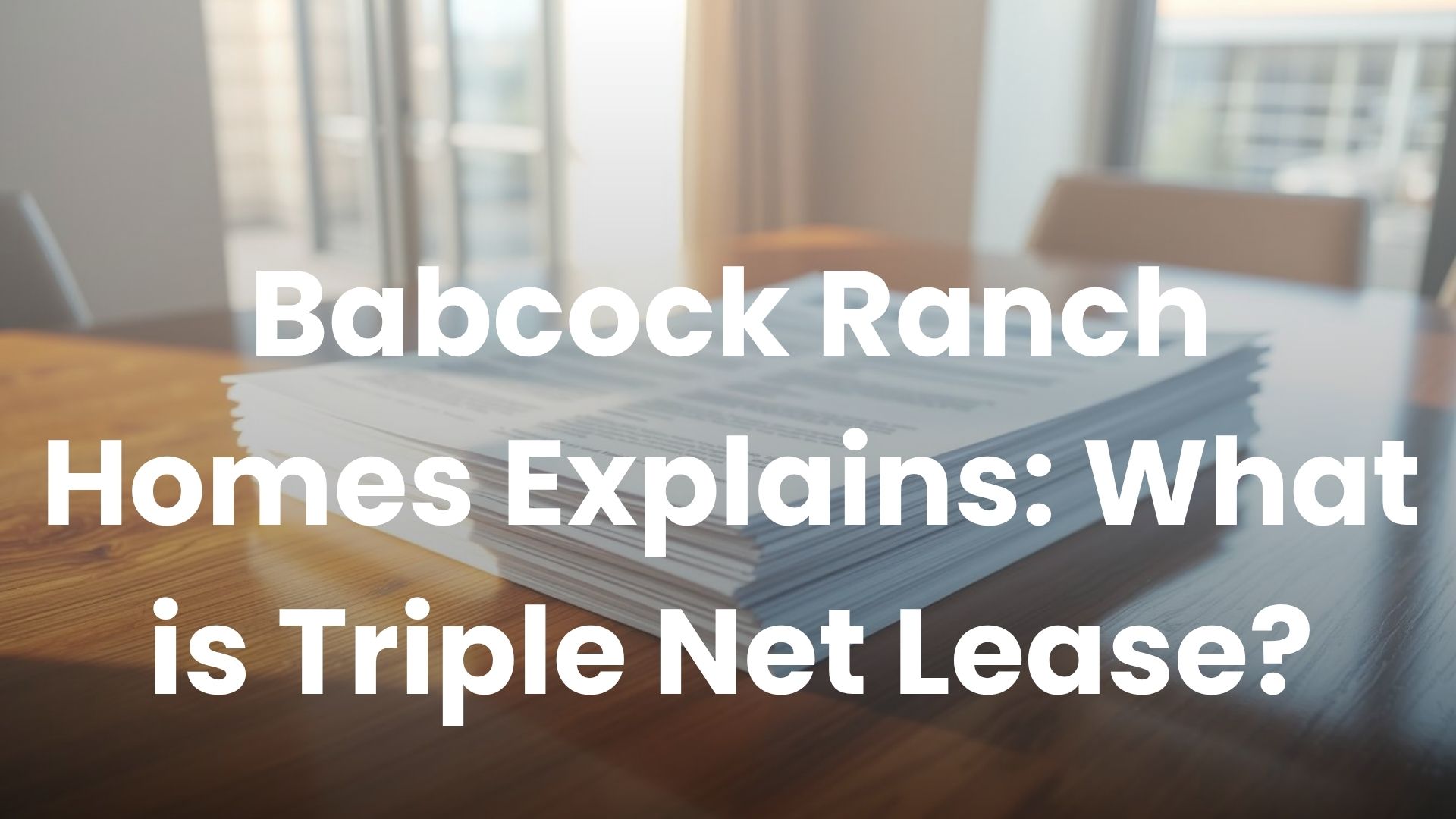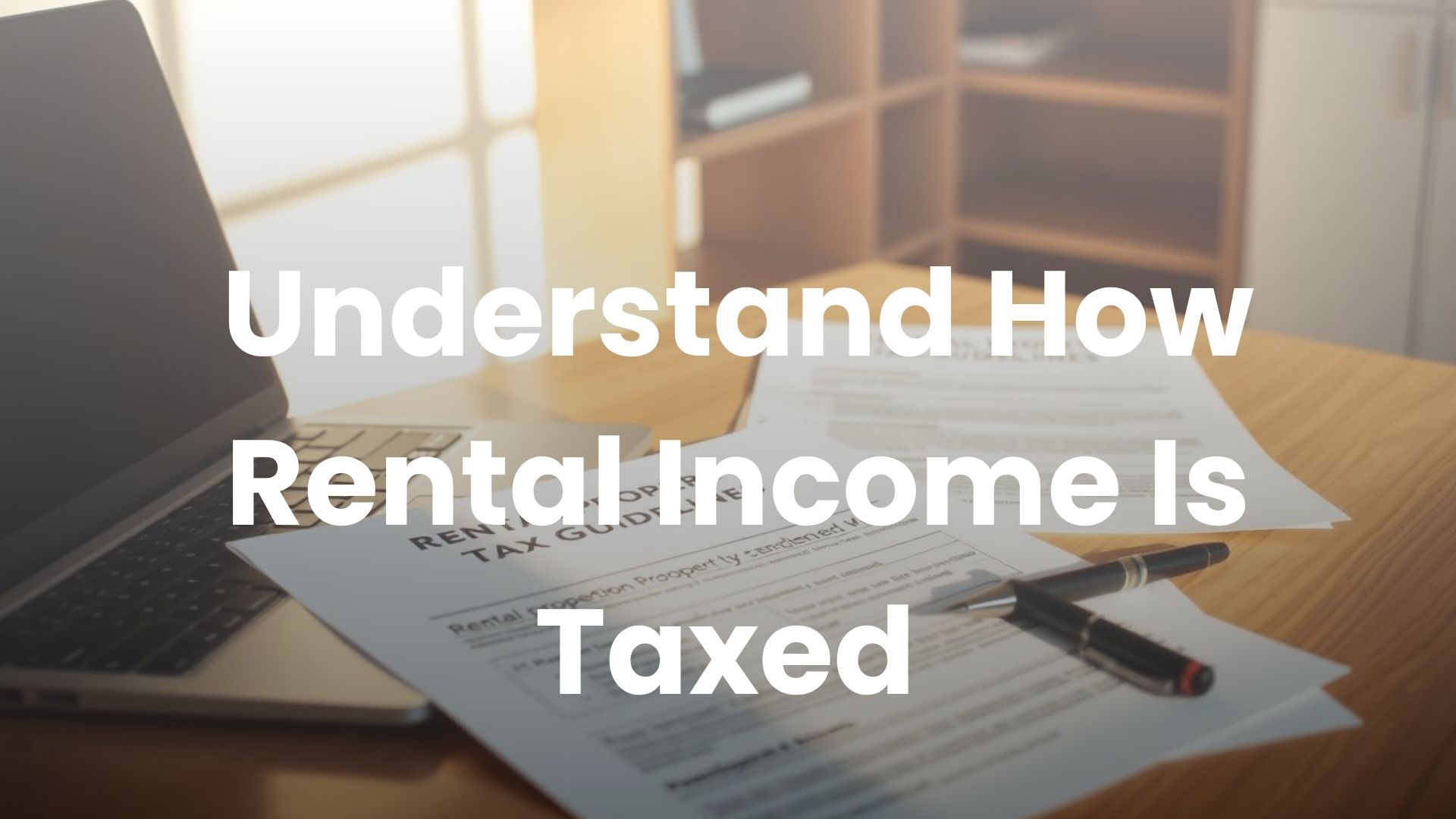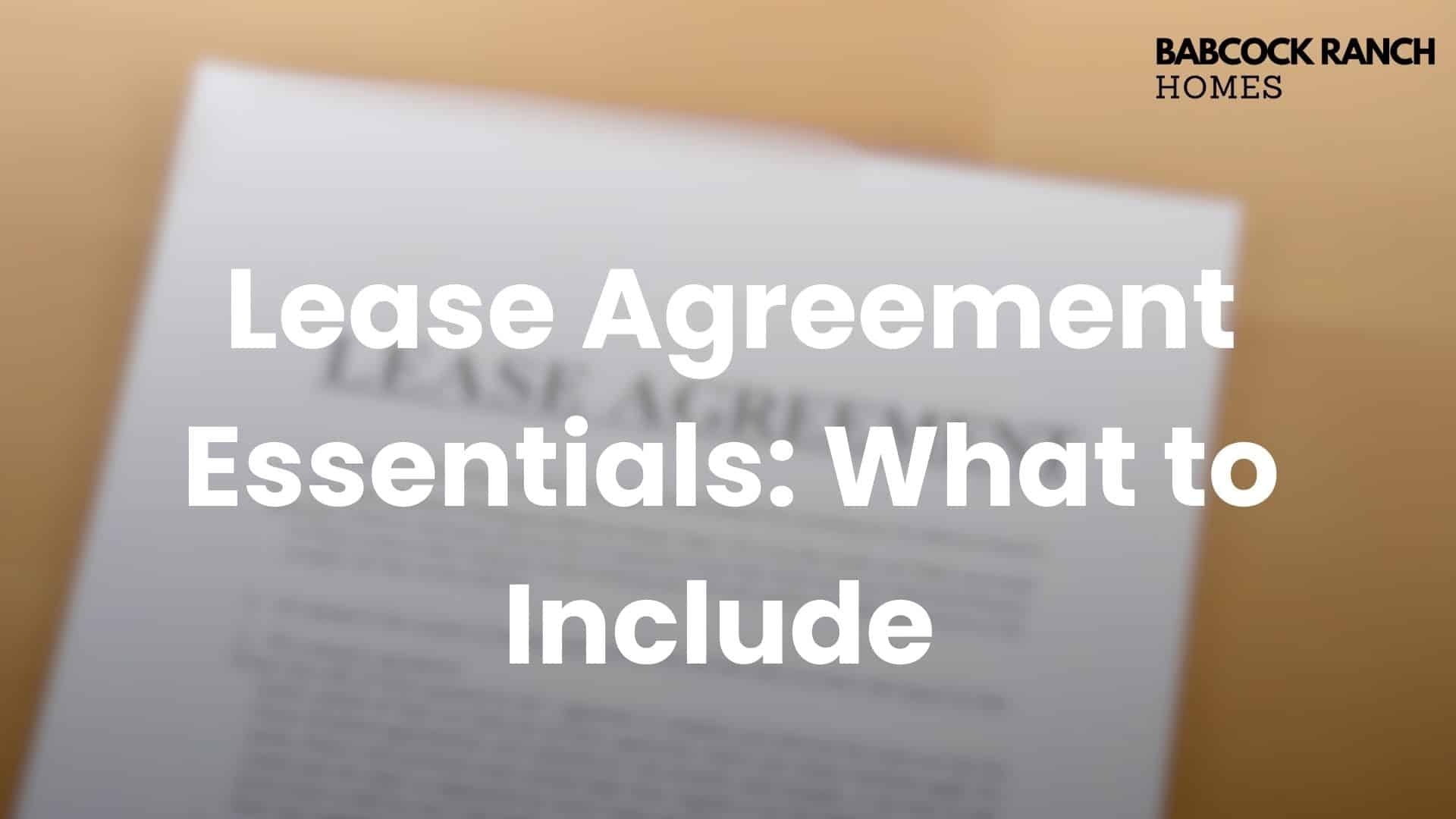
A well-crafted lease agreement is the foundation of a successful landlord-tenant relationship, providing clear expectations and legal protections for both parties. At Babcock Ranch Homes, we specialize in creating comprehensive lease agreements that protect property owners and tenants in Babcock Ranch, Florida.
As a landlord, it’s essential to understand your duties and those of your tenants, as outlined in the lease. Local and state laws have strict requirements, but a lease agreement defines the terms of the rental arrangement. By calling 518-569-7173, you can consult with experts at Babcock Ranch Homes to ensure your lease agreement is thorough and compliant.
A properly structured lease agreement helps prevent disputes, ensures legal compliance, and protects your investment property. Whether you’re a first-time landlord or experienced property owner, having a solid lease agreement in place is crucial for maintaining a professional and legally sound rental operation.
Key Takeaways
- A comprehensive lease agreement establishes clear expectations and legal protections for landlords and tenants.
- Babcock Ranch Homes specializes in creating thorough lease agreements for property owners and tenants.
- Understanding the essential components of a lease agreement helps prevent disputes and ensures legal compliance.
- A properly structured lease agreement protects your investment property and maintains a professional rental operation.
- Consulting with experts at Babcock Ranch Homes can ensure your lease agreement is thorough and compliant.
Understanding the Importance of a Comprehensive Lease Agreement
Crafting a comprehensive lease agreement is a critical step in the rental process, offering protection and clarity for all parties involved. A well-drafted lease serves as a roadmap for the landlord-tenant relationship, outlining the terms and conditions of the rental property.
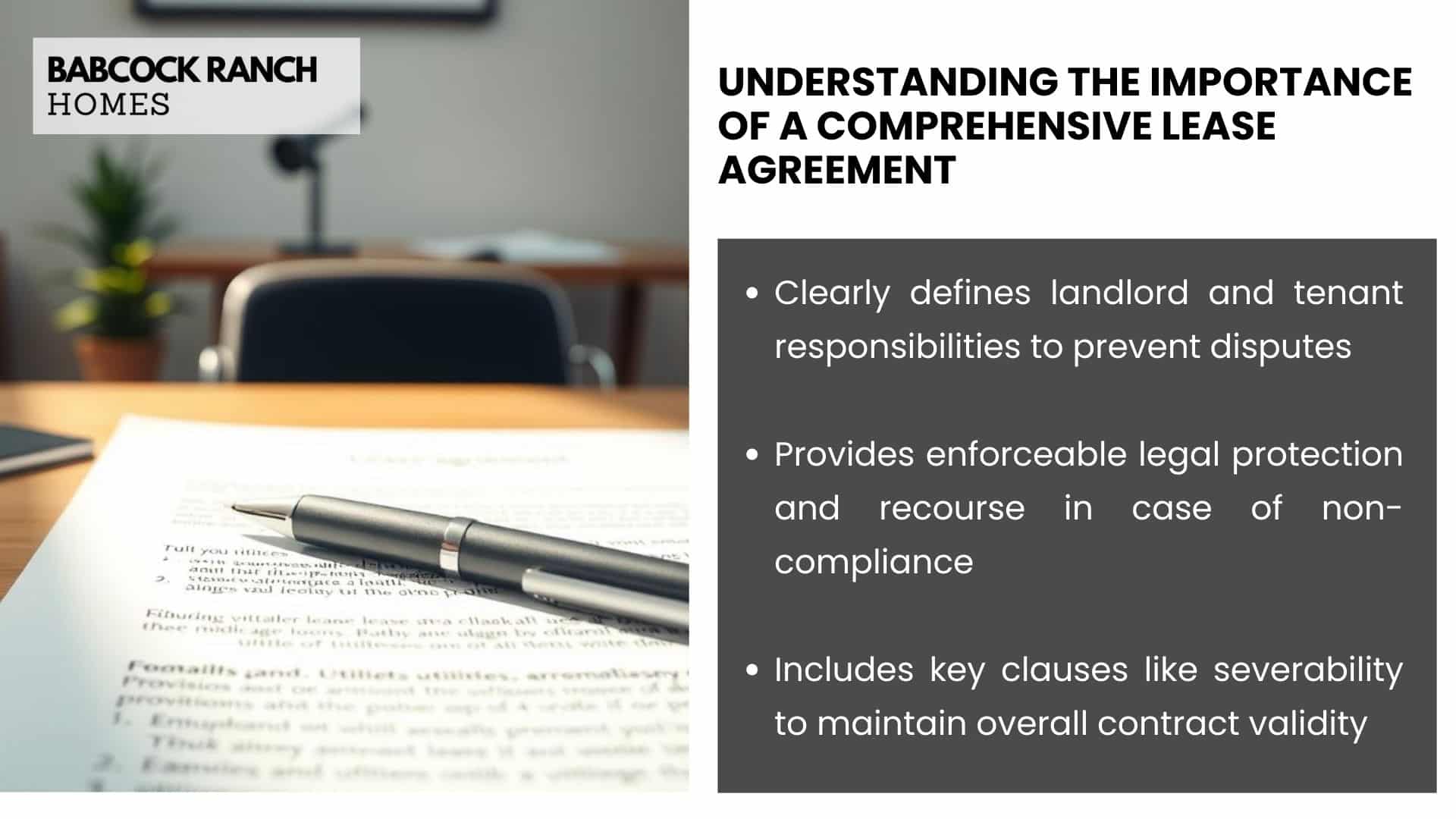
Legal Protection for Landlords and Tenants
A comprehensive lease agreement provides legal protection for both landlords and tenants by clearly defining their responsibilities and obligations. This clarity helps prevent misunderstandings and disputes that may arise during the tenancy. By including specific terms and conditions, a lease agreement ensures that both parties are aware of their rights and duties, thereby reducing the risk of potential conflicts.
For instance, a properly drafted lease agreement can help protect landlords from potential losses by specifying the tenant’s obligations regarding rent payments, property maintenance, and other critical aspects of the tenancy. Similarly, tenants benefit from a clear understanding of their responsibilities and the landlord’s obligations, such as maintenance and repairs.
Enforceability in Court
A well-crafted lease agreement is not only a preventive measure but also a legally binding document that can be enforced in court if disputes arise. The provisions outlined in the lease are enforceable by both parties, providing a legal recourse in case of non-compliance.
A written lease agreement is significantly more effective than an oral agreement, as it provides a clear and tangible record of the agreed-upon terms. Including a severability clause in the lease ensures that if any provision is deemed invalid by the court, the remainder of the agreement remains valid, thereby protecting the overall enforceability of the lease.
| Key Elements | Benefits |
|---|---|
| Clear Terms and Conditions | Prevents misunderstandings and disputes |
| Severability Clause | Protects the overall enforceability of the lease |
| Specific Responsibilities | Defines obligations for landlords and tenants |
“A well-drafted lease agreement is essential for establishing a clear understanding between landlords and tenants, providing a foundation for a smooth and dispute-free rental experience.”
By understanding the importance of a comprehensive lease agreement, landlords and tenants can work together to create a mutually beneficial rental arrangement. This not only enhances the rental experience but also fosters a positive and respectful landlord-tenant relationship.
Basic Information to Include in Your Lease Agreement
A well-structured lease agreement begins with essential details that clarify the terms of the tenancy. At Babcock Ranch Homes, we emphasize the importance of including comprehensive information to protect both landlords and tenants. When you’re preparing to lease a property, having a clear and detailed agreement is crucial.
Property Description and Contact Information
A thorough lease agreement should start by accurately describing the rental property, including its address and any notable features. It’s also vital to include contact information for both the landlord and the tenant. For Babcock Ranch Homes, you can reach us at 518-569-7173 for any inquiries or concerns. This ensures that both parties can be easily contacted for maintenance requests, notices, or other important communications.

Tenant Names and Occupancy Limits
The lease should clearly state the names of all tenants who will be occupying the property. Additionally, it should specify the maximum number of occupants allowed. This helps in maintaining a comfortable and safe living environment. By setting occupancy limits, landlords can prevent overcrowding and potential issues that may arise from it.
Lease Term and Dates
Defining the lease term is critical, including the start and end dates. Most residential leases in Babcock Ranch range from six months to one year, although Babcock Ranch Homes can accommodate different term lengths based on owner and tenant needs. Clearly defining the lease term eliminates confusion and establishes the exact period of the tenancy agreement. It’s beneficial to list the last day of the tenancy to avoid any disputes. For instance, if a lease is for one year, specifying the exact end date protects both parties.
To further clarify the lease term, consider including details about automatic renewal or termination notice requirements. This helps both parties plan ahead for the end of the lease term. For seasonal residents in Florida, shorter lease terms might be appropriate, but should still include clear start and end dates to protect both parties.
What to Include in a Lease Agreement: Essential Financial Terms
Financial terms in a lease agreement are vital for setting clear expectations between landlords and tenants. A well-structured lease ensures that both parties understand their financial obligations, reducing the risk of disputes.
Monthly Rent Amount and Due Date
The lease agreement should clearly state the monthly rent amount and the due date for payment. This clarity helps prevent confusion and ensures timely payments. For instance, specifying that rent is due on the 1st of each month, with a grace period if necessary, sets a clear expectation.
Security Deposit Requirements
Security deposit requirements should be detailed in the lease agreement, including the amount and conditions for its return. As per the data, “Payment Grace Period. The tenant(s) shall have five (5) days of grace to pay any late fee under this agreement.” This provision demonstrates fairness while encouraging timely payments.
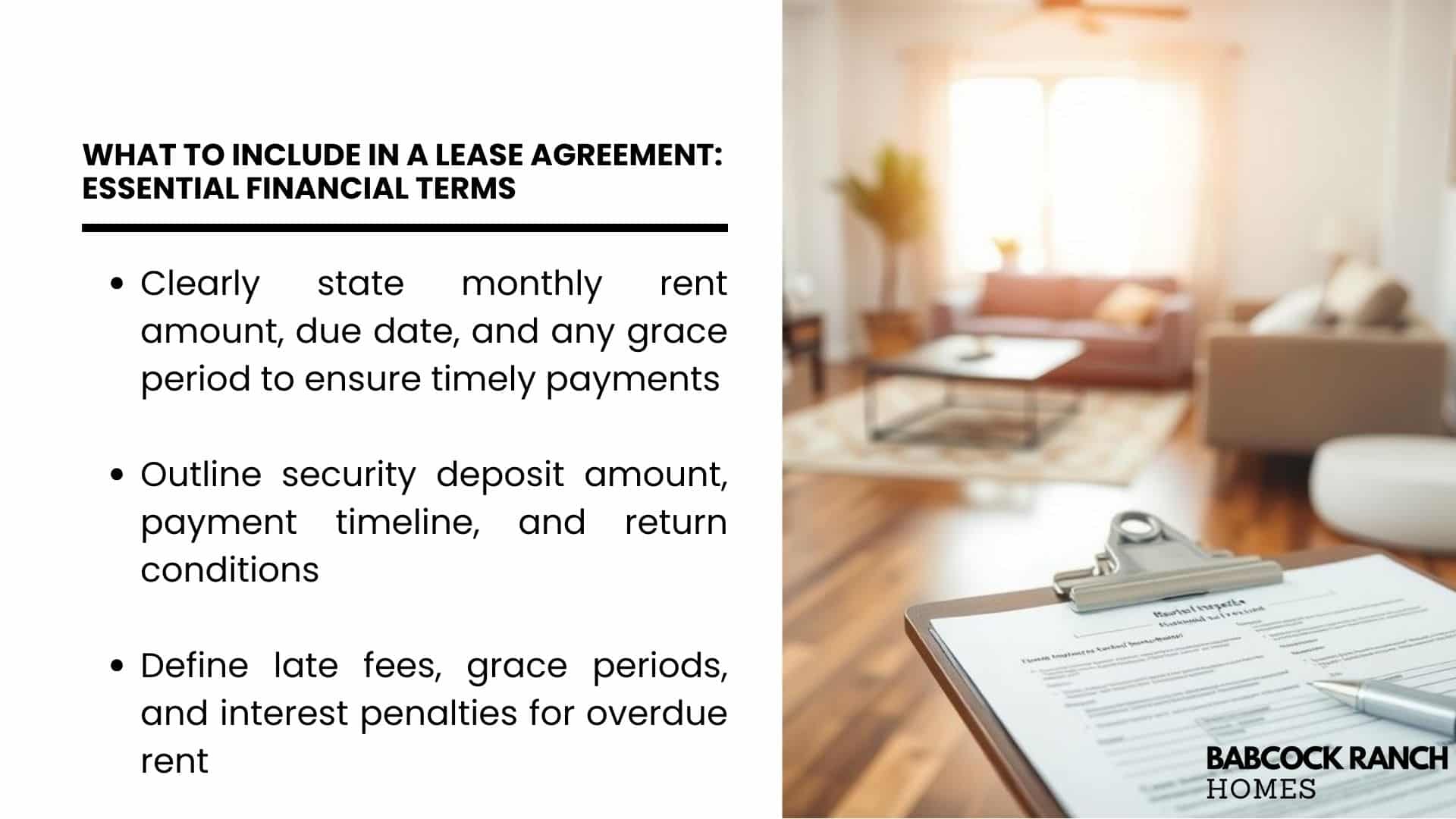
Late Fees and Penalties
When it comes to late fees, the lease agreement should clearly define what constitutes a late payment and specify the exact amount of late fees. As stated, “After this grace period, a default interest rate of two percent (2%) shall apply to the amount due and owing under the agreement, which shall be payable upon demand.” Key considerations include:
- Defining late payments and specifying late fees
- Including a reasonable grace period before applying late fees
- Detailing how late fees are calculated
- Specifying other potential financial penalties
Babcock Ranch Homes recommends structuring late fee policies that comply with Florida regulations, providing a fair yet incentivized approach to timely rent payments.
Property Use and Maintenance Responsibilities
Clearly outlining property use and maintenance responsibilities in the lease agreement helps prevent disputes between landlords and tenants. This clarity ensures that both parties understand their obligations, reducing the risk of misunderstandings that could lead to costly disputes.
Tenant Maintenance Obligations
Tenants are typically expected to maintain the rental property in a clean and habitable condition. This includes performing routine cleaning, reporting any maintenance issues promptly, and taking care of minor repairs. Tenants are also responsible for returning the property in the same condition it was received, allowing for normal wear and tear.
Landlord Repair Responsibilities
Landlords are responsible for maintaining the structural integrity of the property and ensuring that it remains habitable. This includes performing major repairs, maintaining common areas, and addressing any health and safety issues. Landlords must also comply with local housing codes and regulations.
Property Condition Documentation
Documenting the property’s condition at the beginning and end of the tenancy is crucial for determining any damages beyond normal wear and tear. A thorough move-in inspection report should be completed and attached to the lease agreement, including detailed photographs or video documentation. Tenants should be required to report any pre-existing damage within a specific timeframe after moving in. A similar move-out inspection process helps ensure a fair assessment of any damages, and using standardized property condition forms signed by both parties can minimize disputes.
Some key practices to include in the lease agreement are:
- Conducting a thorough move-in inspection and property condition report, documenting all rooms, fixtures, and appliances.
- Including detailed photographs or video documentation as part of the move-in process.
- Requiring tenants to report any pre-existing damage or issues within a specific timeframe.
- Establishing a similar move-out inspection process.
- Using standardized property condition forms signed by both parties.
Key Policies and Rules for Your Rental Property
Establishing clear policies and rules is crucial for maintaining a harmonious rental property environment. These guidelines help ensure that tenants understand their responsibilities and the expectations for their behavior on the property.
Pet Policies
A well-defined pet policy is essential for landlords who allow animals on their rental property. This policy should outline the types of pets permitted, any breed or size restrictions, and associated fees or deposits. It’s also important to specify the tenant’s responsibility for their pet’s behavior and any damage caused by the pet. By clearly defining pet policies, landlords can protect their property and maintain a positive relationship with their tenants.
Smoking Restrictions
Smoking restrictions are another critical aspect of rental property policies. Landlords can designate their property as smoke-free or restrict smoking to specific areas. This policy helps maintain the property’s condition and reduces the risk of fire damage. It’s essential to clearly outline smoking restrictions in the lease agreement to avoid any confusion or disputes.
Noise and Disturbance Limitations
Noise and disturbance limitations are vital for maintaining a peaceful living environment. The lease agreement should include a clear noise and disturbance policy that establishes “quiet hours” and expectations for reasonable noise levels at all times. Specifying consequences for repeated noise violations helps landlords address problems that affect neighboring tenants and property values. The policy should cover all types of disturbances, including loud music, parties, arguments, and noise from televisions, musical instruments, or other sound-producing equipment. Including language about the landlord’s right to terminate the lease for repeated violations protects the peaceful enjoyment of all residents in the community.
- A clear noise policy helps in maintaining a peaceful environment.
- Specifying consequences for noise violations addresses potential problems.
- The policy should cover various types of disturbances.
- Landlords can terminate the lease for repeated noise violations.
By establishing these key policies and rules, landlords can create a positive and respectful rental community, ensuring a pleasant living experience for their tenants.
Utilities and Services Provisions
Outlining utilities and services in the lease agreement is essential for clarity and transparency. At Babcock Ranch Homes, we ensure that our lease agreements comprehensively cover these aspects to avoid any confusion between landlords and tenants.
Responsibility for Utility Payments
The lease agreement should clearly state which utilities are the responsibility of the tenant and which are covered by the landlord. This includes electricity, water, gas, and internet services. For instance, at Babcock Ranch, Florida, tenants are typically responsible for their electricity and internet services, while water and gas might be included in the rent or billed separately.
It’s also important to specify how utility payments will be handled, whether directly by the tenant to the service provider or through the landlord. This clarity helps prevent misunderstandings and ensures a smooth tenant experience.
Included Services and Amenities
The lease should detail all services included in the rent, such as trash collection, landscaping, and pest control provided by Babcock Ranch Homes. Additionally, access to community amenities like pools, gyms, and clubhouses should be outlined to help tenants understand the full value of their rental agreement.
For furnished properties, a detailed inventory of included furniture and fixtures should be attached to the lease. This practice helps prevent disputes about missing or damaged items at move-out. You can reach out to us at 518-569-7173 for more information on how to structure your lease agreement.
Access and Entry Rights
Understanding the balance between a landlord’s need to access the property and a tenant’s right to privacy is crucial. A well-structured lease agreement should clearly outline the terms under which a landlord can enter the rental property.
Landlord’s Right to Enter
In general, landlords are permitted to enter the property for certain situations, such as repairs or inspections, with proper notice. The specific requirements for notice and the conditions under which a landlord can enter vary by state. For instance, Florida law typically requires landlords to provide reasonable notice, usually 12-24 hours, before entering a rental property, except in emergencies.
Notice Requirements for Property Access
The lease agreement should specify how notice will be given to tenants, whether by email, text, or written notice, and what constitutes sufficient notice. It’s also beneficial to include specific time windows for entry, such as between 9 AM and 5 PM on weekdays, to respect tenant privacy while allowing necessary access. Tenants should be able to request rescheduling if the proposed entry time presents a hardship.
Babcock Ranch Homes recommends documenting all property access with written notices to maintain clear records and prevent disputes about proper notification. By including these details in the lease agreement, landlords can avoid claims of illegal entry or violation of privacy rights.
Lease Termination and Renewal Terms
The terms governing lease termination and renewal are essential components of a comprehensive lease agreement. These provisions help prevent misunderstandings and ensure a smooth transition, whether the tenant is renewing their lease or vacating the property.
Early Termination Conditions
In the event a tenant needs to terminate their lease early, the lease agreement should specify the conditions and penalties associated with early termination. Typically, this involves providing a certain number of days’ notice and potentially paying a fee or forfeiting the security deposit. For instance, if the tenant doesn’t provide adequate notice, they may be held liable for additional rent until a new tenant is found or until the end of the lease term.
Renewal Process
The lease agreement should outline the renewal process, including the notice period required for renewal or termination. If the tenant fails to provide proper notice, they may be obligated to pay rent beyond their intended move-out date. It’s crucial to specify the renewal terms to avoid disputes and ensure the landlord can plan accordingly. Clearly defining the renewal process protects both parties’ interests.
Move-Out Procedures
To ensure a smooth transition when the tenant moves out, the lease agreement should detail specific move-out procedures. These may include:
- Property cleaning requirements to return the property in a “broom clean” condition.
- The process for returning keys and submitting a forwarding address.
- A move-out inspection to assess any damages and determine the security deposit refund.
- A timeline for returning the security deposit, typically within 15-30 days in Florida.
By including these details, landlords can set clear expectations and minimize potential disputes when the tenant vacates the property. Babcock Ranch Homes recommends providing tenants with a detailed move-out checklist to maximize their security deposit refund.
Legal Disclosures and Compliance Requirements
To ensure a lease agreement is legally binding and protective of both parties’ interests, it must include specific disclosures as mandated by Florida state law and federal regulations. This is particularly important for properties in Babcock Ranch, Florida, where local laws and regulations may have unique stipulations.
State-Specific Disclosures for Florida
Florida law requires certain disclosures to be included in lease agreements. For instance, landlords must disclose the name and address of the property owner or manager. Additionally, Florida Statutes mandate that landlords provide tenants with information about mold, as part of the required disclosures. “Florida law is clear on the responsibilities of landlords to maintain a habitable living environment,” as noted by Florida’s Department of Business and Professional Regulation.
- Required disclosures include the identity of the landlord or property manager.
- Tenants must be informed about known mold issues in the rental property.
Federal Disclosure Requirements
At the federal level, lease agreements must comply with several regulations. For properties built before 1978, landlords are required to disclose information about lead-based paint hazards, providing tenants with an EPA-approved pamphlet. Compliance with the Fair Housing Act is also mandatory, ensuring that landlords do not discriminate against tenants based on race, color, national origin, religion, sex, familial status, or disability.
As stated by the EPA, “if your home was built before 1978, you should receive a lead-based paint disclosure form from your landlord.” Babcock Ranch Homes ensures that all lease agreements are compliant with these federal regulations, providing a secure and legally sound rental experience for both landlords and tenants.
Conclusion: Creating a Solid Lease Agreement with Babcock Ranch Homes
For landlords and tenants in Babcock Ranch, a comprehensive lease agreement is essential for a smooth rental experience. A well-crafted lease agreement protects both parties from misunderstandings and legal complications, serving as the foundation of a successful rental property operation.
Babcock Ranch Homes, reachable at 518-569-7173, specializes in creating customized lease agreements that comply with all Florida state laws while addressing the specific needs of Babcock Ranch properties. By including all the essential elements covered in this guide, from basic information to specific policies and legal disclosures, you create a document that serves as both a legal protection and operational roadmap.
It’s crucial to review your lease agreement periodically to ensure it remains compliant with changing laws and reflects current property conditions and market standards. For professional assistance with creating or reviewing your lease agreement, contact Babcock Ranch Homes at 518-569-7173 to ensure your rental property is protected by a thorough, legally sound contract.
By doing so, you’ll be able to maintain a positive landlord-tenant relationship, minimize potential disputes, and ensure a successful rental experience in Babcock Ranch, Florida.










